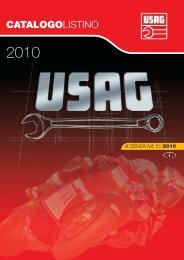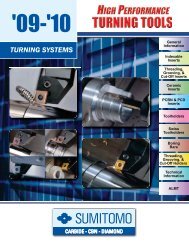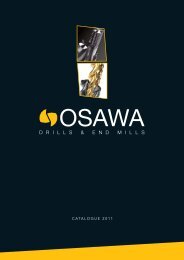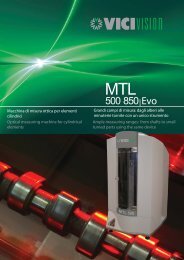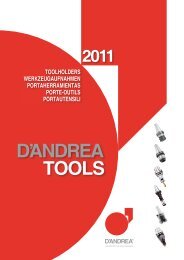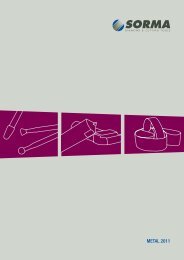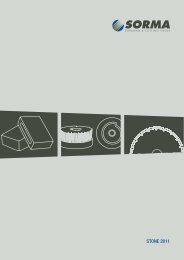- Page 3:
Management and Company StructureInn
- Page 9 and 10:
Guhringno.Std. range/pageFeeds &Spe
- Page 11 and 12:
SelectSelectSelectSelect1452 609 55
- Page 13:
HT 800 WPSERIES 4112 4113 4114 4107
- Page 18 and 19:
HSS / Cobalt DrillsCenterDrills /Co
- Page 20 and 21:
High-Performance Cutting Toolsfor C
- Page 22 and 23:
High-Performance Drill Recommendati
- Page 24 and 25:
Jobber Length (5xD) DrillsSeries 20
- Page 28 and 29:
Jobber Length (5xD) DrillsSeries 30
- Page 30 and 31:
High-Performance Drill Recommendati
- Page 33 and 34:
Stainless steel alloysExtra Length
- Page 35 and 36:
High tensile steelsStub Length (3xD
- Page 37 and 38:
High tensile steelsExtra Length (
- Page 39 and 40:
Aluminum and aluminum alloysStub Le
- Page 41 and 42:
Aluminum and aluminum alloysExtra L
- Page 43:
Cast IronStub Length (3xD) DrillsSe
- Page 46 and 47:
High-Performance Drill Recommendati
- Page 48 and 49:
Jobber Length (5xD) DrillsSeries 64
- Page 50 and 51:
Standard drill offering
- Page 52 and 53:
Twist Drills5xD Series 205Applicati
- Page 54 and 55:
Series 205Twist DrillsSpeeds & Feed
- Page 56 and 57:
Twist Drills5xD Series 206Applicati
- Page 58 and 59:
Twist Drills5xD Series 207Applicati
- Page 60 and 61:
Twist Drills5xD Series 208Applicati
- Page 62 and 63:
Twist Drills10xD Series 217Applicat
- Page 64 and 65:
Twist Drills10xD Series 219Applicat
- Page 66 and 67:
Series 223Twist DrillsSpeeds & Feed
- Page 68 and 69:
Twist Drills3xD Series 224Applicati
- Page 70:
Twist Drills3xD Series 226Applicati
- Page 73 and 74:
5xD Series 245Application Materials
- Page 75 and 76:
Series 245Speeds & Feeds informatio
- Page 77:
Series 257Diameter (d1)Shanksizel1m
- Page 80 and 81:
Twist DrillsMetricCenter Drill/Coun
- Page 83 and 84:
GM300HSK/ISO TOOL HOLDERS,HSK CLAMP
- Page 85 and 86:
Series 301Speeds & Feeds informatio
- Page 87 and 88:
Series 303Diameter (d1)d2mml1mml2mm
- Page 89 and 90:
Series 305Speeds & Feeds informatio
- Page 91 and 92:
Series 308Speeds & Feeds informatio
- Page 93 and 94:
3xD Series 329Application Materials
- Page 95:
10xD Series 336Application Material
- Page 98 and 99:
Twist Drills10xD Series 390Applicat
- Page 100 and 101:
Twist DrillsExtra Length#1Series 50
- Page 102 and 103:
Twist DrillsExtra Length#3Series 50
- Page 104 and 105:
Series 515Twist DrillsSpeeds & Feed
- Page 106 and 107:
Twist DrillsExtra Length#1Series 52
- Page 108 and 109:
Twist Drills5xD Series 530Applicati
- Page 110 and 111:
Series 535Twist DrillsSpeeds & Feed
- Page 112 and 113:
Twist Drills5xD Series 549Applicati
- Page 114 and 115:
Twist Drills5xD Series 550Applicati
- Page 116 and 117:
Twist Drills3xD Series 552Applicati
- Page 118 and 119:
Twist Drills3xD Series 553Applicati
- Page 120 and 121:
Twist Drills5xD Series 605Applicati
- Page 122 and 123:
Twist Drills5xD Series 609Applicati
- Page 124 and 125:
Twist DrillsExtra Length#1Series 61
- Page 126 and 127:
Twist Drills5xD Series 622Applicati
- Page 128 and 129:
Series 651Twist DrillsSpeeds & Feed
- Page 130 and 131:
Twist Drills5xD Series 652Applicati
- Page 132 and 133:
Twist Drills3xD Series 653Applicati
- Page 134 and 135:
Twist Drills5xD Series 654Applicati
- Page 136 and 137:
Series 657Twist DrillsSpeeds & Feed
- Page 138 and 139:
Twist Drills3xD Series 659Applicati
- Page 140 and 141:
Twist DrillsMicro Series 660 Applic
- Page 142 and 143:
Twist Drills10xD Series 666Applicat
- Page 144 and 145:
Series 667Twist DrillsSpeeds & Feed
- Page 147 and 148:
Extra Length#1Series 670Application
- Page 149 and 150:
3xD Series 730Application Materials
- Page 151 and 152:
Series 732Speeds & Feeds informatio
- Page 153 and 154:
Series 768Diameter (d1)d2mml1mml2mm
- Page 155 and 156:
5xD Series 1068Application Material
- Page 157 and 158:
5xD Series 1132Application Material
- Page 159 and 160:
Series 1183Speeds & Feeds informati
- Page 161 and 162:
Series 1184Speeds & Feeds informati
- Page 163 and 164:
5xD Series 1223Application Material
- Page 165 and 166:
5xD Series 1243Application Material
- Page 167 and 168:
Series 1452Speeds & Feeds informati
- Page 169 and 170:
3xD Series 1702Application Material
- Page 171 and 172:
3xD Series 2463Application Material
- Page 173 and 174:
5xD Series 2464Application Material
- Page 175 and 176:
3xD Series 2477Application Material
- Page 177 and 178:
5xD Series 2479Application Material
- Page 179 and 180:
8xD Series 2601Application Material
- Page 181 and 182:
Indexable Insert DrillsTwist Drills
- Page 183 and 184:
RT 800 WPBodiesIndexable Insert Dri
- Page 185 and 186:
HT 800 WPBodiesIndexable Insert Dri
- Page 187 and 188:
HT 800 WPInsertsIndexable Insert Dr
- Page 189 and 190:
HT 800 WPBodiesIndexable Insert Dri
- Page 191 and 192:
Until recently, the economical prod
- Page 193 and 194:
Series 4044Speeds & Feeds informati
- Page 195 and 196:
3xD Series 5510Application Material
- Page 197 and 198:
5xD Series 5511Application Material
- Page 199 and 200:
7xD Series 5512Application Material
- Page 201 and 202:
10xD Series 5513Application Materia
- Page 203 and 204:
Series 5514Speeds & Feeds informati
- Page 205 and 206:
Series 5515Speeds & Feeds informati
- Page 207 and 208:
5xD Series 5519Application Material
- Page 209 and 210:
3xD Series 5521Application Material
- Page 211 and 212:
5xD Series 5523Application Material
- Page 213 and 214:
12xD Series 5525Application Materia
- Page 215 and 216:
Series 5610Speeds & Feeds informati
- Page 217 and 218:
Series 5611Speeds & Feeds informati
- Page 219 and 220:
4xD Series 6068Application Material
- Page 221 and 222:
10xD Series 6070Application Materia
- Page 223 and 224:
Micro drill Exclusive Line ® Appli
- Page 225 and 226:
Series 6501Speeds & Feeds informati
- Page 227 and 228:
Series 6502Speeds & Feeds informati
- Page 230 and 231:
Twist Drills3xD Series 8510Applicat
- Page 232 and 233:
Twist Drills5xD Series 8511Applicat
- Page 234 and 235:
Hollfelder-Guhring Cutting ToolsAre
- Page 236 and 237:
Twist DrillsHOLLFELDERDrill/Chamfer
- Page 238 and 239:
Twist DrillsHOLLFELDERDrill/Chamfer
- Page 240:
Twist DrillsAssembly InstructionsHO
- Page 244 and 245:
PCD and CBN tools from GuhringPCD a
- Page 246 and 247:
Advantages and application of PCD a
- Page 248 and 249:
Field of application - Aircraft ind
- Page 250 and 251:
Process design for optimal resultsP
- Page 252 and 253:
Adjustable, multi-fluted PCD-tipped
- Page 254 and 255:
Adjustable, multi-fluted PCD-tipped
- Page 256 and 257:
PCD/CBN toolsIntelligent solutionsf
- Page 258 and 259:
HOLLFELDERCUTTING TOOLSEccentric bo
- Page 260: MODULAR TOOLING SYSTEMS
- Page 263 and 264: The HSK interfaceThe wedging effect
- Page 265 and 266: Description4509 ISO taper basic ada
- Page 267 and 268: Tool HoldersDescription4206 Inserts
- Page 269 and 270: Direct installationin the spindlead
- Page 272 and 273: Application in machining centres,mi
- Page 274 and 275: Guhring is heavily engaged in the s
- Page 276 and 277: Our 4-point-clamping sets for minim
- Page 278 and 279: Modern machining processes place he
- Page 280 and 281: Guhring‘s shrink fit chucks ensur
- Page 282 and 283: Pre-requisite for optimal machining
- Page 284: TECHNICAL SECTION
- Page 287 and 288: Decimal Equivalents - drill sizes a
- Page 289 and 290: General InformationTypical hole qua
- Page 291 and 292: TroubleshootingHeavy chisel edge we
- Page 293 and 294: General informationFeed Force and T
- Page 295 and 296: 100200100300200400300500600700Gener
- Page 297 and 298: DimensionsStraight shank twist dril
- Page 299 and 300: DimensionsCarbide twist drills (Rat
- Page 301 and 302: DimensionsStraight shank core drill
- Page 303 and 304: DimensionsStraight shank subland dr
- Page 305 and 306: DimensionsMorse taper subland drill
- Page 307 and 308: Shank designsCarbide straight shank
- Page 309: The HSK interfaceGeneral overview o
- Page 313 and 314: Machining technologyDry machining a
- Page 315 and 316: Machining technologyThe Guhring MQL
- Page 317 and 318: TolerancesSpecial point geometryand
- Page 319 and 320: Quote Request Form®Date Received:
- Page 321 and 322: Precision of single-fluted gun dril
- Page 323 and 324: Single-fluted gun drill EB 100To en
- Page 325 and 326: Single-fluted gun drills EB 80To en
- Page 327 and 328: Two-fluted gun drills with solid ca
- Page 329 and 330: Single-fluted gun drills EB 800Rang
- Page 331 and 332: Dx0,13Additional technical paramete
- Page 333 and 334: Guhring tool materialsSuperhard too
- Page 335 and 336: Guhring tool materialsBasic charact
- Page 337 and 338: Coatings, surface finishesSurface f
- Page 339 and 340: RPM =SFMx 3.82DIAM. in.Series # 205
- Page 341 and 342: RPM =SFMx 3.82DIAM. in.Series # 217
- Page 343 and 344: RPM =SFMx 3.82DIAM. in.Series # 225
- Page 345 and 346: RPM =SFMx 3.82DIAM. in.Series # 257
- Page 347 and 348: RPM =SFMx 3.82DIAM. in.Series # 305
- Page 349 and 350: RPM =SFMx 3.82DIAM. in.Series # 336
- Page 351 and 352: RPM =SFMx 3.82DIAM. in.Series # 502
- Page 353 and 354: RPM =SFMx 3.82DIAM. in.Series # 524
- Page 355 and 356: RPM =SFMx 3.82DIAM. in.Series # 535
- Page 357 and 358: RPM =SFMx 3.82DIAM. in.Series # 552
- Page 359 and 360: RPM =SFMx 3.82DIAM. in.Series # 617
- Page 361 and 362:
RPM =SFMx 3.82DIAM. in.Series # 651
- Page 363 and 364:
RPM =SFMx 3.82DIAM. in.Series # 657
- Page 365 and 366:
RPM =SFMx 3.82DIAM. in.Series # 664
- Page 367 and 368:
RPM =SFMx 3.82DIAM. in.Series # 669
- Page 369 and 370:
RPM =SFMx 3.82DIAM. in.Series # 732
- Page 371 and 372:
RPM =SFMx 3.82DIAM. in.IPM = IPR x
- Page 373 and 374:
RPM =SFMx 3.82DIAM. in.Series # 113
- Page 375 and 376:
RPM =SFMx 3.82DIAM. in.Series # 122
- Page 377:
RPM =SFMx 3.82DIAM. in.Series # 166
- Page 380 and 381:
Using These Tables. The Speeds & Fe
- Page 382 and 383:
Feeds/Speeds380Using These Tables.
- Page 384 and 385:
Using These Tables. The Speeds & Fe
- Page 386 and 387:
Using These Tables. The Speeds & Fe
- Page 388 and 389:
Using These Tables. The Speeds & Fe
- Page 390 and 391:
Using These Tables. The Speeds & Fe
- Page 392 and 393:
Using These Tables. The Speeds & Fe
- Page 394 and 395:
Feeds/Speeds392Using These Tables.
- Page 396 and 397:
Feeds/Speeds394Using These Tables.
- Page 398 and 399:
Feeds/Speeds396Using These Tables.
- Page 400 and 401:
Feeds/Speeds398Using These Tables.
- Page 402 and 403:
Feeds/Speeds400Using These Tables.
- Page 404 and 405:
Feeds/Speeds402Using These Tables.
- Page 406 and 407:
Feeds/Speeds404Using These Tables.
- Page 408 and 409:
Feeds/Speeds406Using These Tables.
- Page 410 and 411:
Using These Tables. The Speeds & Fe
- Page 412:
www.guhring.comForm #01-2010Guhring



